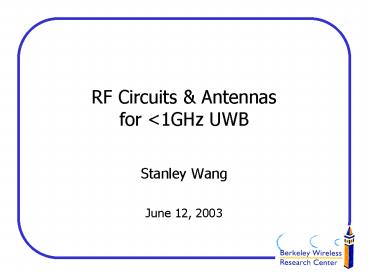RF Circuits - PowerPoint PPT Presentation
1 / 15
Title:
RF Circuits
Description:
E-fields in all directions are with almost the same waveform ... H-bridge pulser to drive inductive load. Flexible driving force by parallel structure ... – PowerPoint PPT presentation
Number of Views:33
Avg rating:3.0/5.0
Title: RF Circuits
1
RF Circuits Antennasfor lt1GHz UWB
- Stanley Wang
- June 12, 2003
2
Introduction
Whats special about UWB RF circuits?
- No tuned circuit
- Couldnt just look at one frequency point anymore
- Phase response is important
- Requires constant group delay to avoid distortion
of the waveform
Why talk about antennas?
- Everything varies with frequency
- Radiation pattern, directivity, impedance, etc..
- Couldnt draw antenna as a 50ohm resistor. Have
to learn more
3
UWB Antennas
- UWB antennas for indoor wireless applications
- Small size
- Broadband
- Omni-directional
- Small size ? Narrowband
- Antenna Q (?3)/(antenna size)
- Build a circuit network to reflect the impedance
variation - Small size ? Omni-directional
- Spatial phase difference is small
- Variation of radiation pattern in low freq regime
is small
6cm Dipole Antenna Input Impedance
Resistance
Reactance
Reactance Dominates!
4
Small Antenna Modeling
Take small loop antenna as an example
- Curve-fitting the input impedance
- Only one resistor
- E-fields in all directions are with almost the
same waveform - By superposition, voltage waveform across Rrad is
equal to the far-zone E-field waveform - Estimate radiated E-field in SPICE
5
UWB Pulser/Antenna Co-design
- Large Current Radiator (LCR) as the TX antenna
- Notch filter for pulse-shaping FCC radiation
mask
- H-bridge pulser to drive inductive load
- Flexible driving force by parallel structure
6
H-bridge Operations (Transmit 0)
- EP0 EN0 turned on
- Current flows from Vdd to Gnd thru LCR
- Fast-rising voltage at LCR terminals generates a
positive Gaussian pulse
- EN0 off and EP0 on
- Current flows back to Vdd
- Fast-falling voltage at LCR terminals generates a
negative Gaussian pulse
7
H-bridge Simulation Results
- Doublet is generated
- Pulse-width 1ns
- Smoothed after low-pass filtering at the receiver
- Meet FCCs rule
- EIRP will increase when PRF(Pulse Repetition
Freq) increases
VRrad
FCC Mask
Vfiltered
EIRP (dBm/MHz)
Time(ns)
Frequency (GHz)
8
UWB Receiver Front-end
- Waveform of the source imitates the radiated
E-field - Source impedance equal to antenna input impedance
- LNA ? Matching Network
9
Sub-mW UWB LNA Design
- Specifications
- Fully-differential for on-chip interference
immunity - Voltage Gain gt 15dB
- 3dB BW 0.11GHz
- NF lt 6dB
- Linearity doesnt matter
- Constant group delay
- Input impedance 50ohm
- Goal Minimize power consumption (lt 1mW)
- Low input impedance sets the power consumption
- What LNA topology should be used?
Z
LNA
LNA
10
Existing Wideband LNAs
Shunt-Feedback
R-terminated
Common-Gate
Rin RT
Rin 1/gm
Rin Rf/(1gmRL)
- Resistive-terminated LNA has very bad NF
- Shunt-FB and CG LNAs need gm 40mA/V which
makes sub-mW power consumption unfeasible
11
Current-Reuse Technique
Shunt-Feedback
Common-Gate
- PMOS are added in as amplifying devices
- No extra DC current
- Gm gmn gmp
- Rin is halved
- Voltage gain is doubled
- NF decreased by 3dB
- BW decreased but OK
- Still burn gt 1mW
Rin 1/(gmngmp) Rin,diff 2/(gmngmp)
Rin 1/(gmngmp) Rin,diff 2/(gmngmp)
12
FB/CG Hybrid LNA
- Mp1/Mn1/Rf1act as FB Amp to Vin and CG Amp to
Vin- - Mp2/Mn2/Rf2 act as FB Amp to Vin- and CG Amp to
Vin - Rin 1/ 2(gmngmp)
- For Rin 50ohm,
- gmn gmp 5mA/V
- ? 8 times smaller than 40mA/V in CG or Shunt-FB
amplifier! - ? sub-mW LNA feasible
- Av 2(gmngmp)Rf
13
LNA Schematic Simulation
Av
NF
dB
s11
Frequency(MHz)
- Back-gate Cross-coupling enhances Gm by 10
- Power 0.61mW
- All the specs are met
14
UWB LNA Layout
- ST Microelectronics 0.13um CMOS triple-well
process - Layout area
- 59um x 45um
- Common-centroid layout for good transistor
matching - Dummy for good resistor matching
- Capacitors not shown
Mb1 Mb2
Mp1
Mp2
Rf2
Mp1
Mp2
Rf1
59um
Mn2
Mn1
Mb3 Mb4
Mn2
Mn1
45um
15
Future Work
- Wideband matching networks will be investigated
to complete the receiver front-end - How much can we gain from them?
- Compare performance of different antenna/LNA
combinations at the receiver - Loop antenna? Monopole antenna?
- Research on 3-10GHz UWB front-end
- Antenna Q is small, but directivity goes up
- Different methodology is needed































